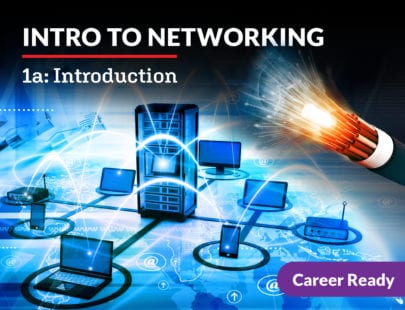
Advanced Networking 1a: Introduction
The world has never been more connected than it is today and through advancing network technologies, tomorrow will be even more tightly united. In this course, you will learn about a variety of different networks, their layers, and the different needs they address. You’ll uncover best practices for setting up secure remote access connections, techniques to troubleshoot and think strategically, and correct documentation. Lastly, you’ll learn tips to successfully communicate in the workplace. Get ready to support tomorrow’s connectedness today!
Units at a Glance
Unit 1: Ports and Protocols
Throughout history, communication has always been on the forefront of progress. The ancient Romans developed roadways to connect parts of the empire and increase its influence. The Pony Express used a relay method of exchanging exhausted horses for rested horses to deliver messages more efficiently. The ability to communicate has shifted the landscape of the world, shaped cultures, and propelled civilization into the modern era. Computer networks have created the most connected world—far more than any other advancement. The ability to video chat with a friend on the other side of the world is both impressive and fascinating. How can information travel that quickly? What components are in place to make it work so seamlessly? We’ll explore these questions and many more, so let’s dive in!
What will you learn in this unit?
- Discuss the fundamental principles that guide communication in a network
- Describe essential protocols and their function within computer networks
- Define the functions of ports in managing network traffic
- Compare and contrast different types of computer networks
- Identify the pros and cons of different protocols for routing optimization
Unit 2: The Fundamentals of Networking
The same fundamental structures create the foundation for networking, whether it be small-scale networks or global networks. We use foundational structures to organize, implement, and troubleshoot networks so that they can work seamlessly, no matter the scale that they are operating on. These networking standards are accepted around the world, and without this global adherence to the same standards, networks as we know them today wouldn’t exist. These models were created many years ago, but they haven’t lost their relevance as the basis for network transmission. There have been advancements and changes, but the core pieces of methodology remain consistent and resilient when offering efficient networks on every scale. So, since it looks like these networking models are here to stay, let’s jump in and learn about them!
What will you learn in this unit?
- Identify and describe the layers of the OSI model
- Compare the TCP/IP model to the OSI model
- Explain the function of software-defined networks and their role in modern computer networks
- Discuss troubleshooting methodologies
Unit 3: Data and Cabling
Networks can be incredibly complex, requiring a vast amount of hardware and software working in concert to operate successfully. As we discussed in the last unit, we use the TCP/IP and OSI models to break networks down into different layers so that they can be better understood. In this unit, we’ll take a closer look at the physical layer so that we can understand the actual physical components that create the bases of networks and how these devices pass information. Let’s get to the bottom of things!
What will you learn in this unit?
- Identify the common types of cables in an Ethernet network
- Compare and contrast various cables and their capabilities
- Explain transmission modes and the path that information travels
- Discuss scenarios that require Power over Ethernet (PoE) implementations
Unit 4: Types of Networks and Infrastructure
Can you imagine what our world would look like today without networks? Some networks are built physically, and some are organized virtually in a theoretical network structure. As technologies advance, the configurations of these networks become more autonomous with hardware that can make decisions for users dynamically. However, networks still require humans to address users’ needs by correctly configuring the devices for optimal functionality. Whether it is a smart fridge that orders groceries or a multi-million-dollar precision machine that needs schematics, both rely on networks to function. There are so many types of networks for a variety of needs, and we have only touched the surface!
What will you learn in this unit?
- Define major network types, their uses, and their purposes
- Describe various types of WANs, from legacy technologies to modern-day implementations
- Identify the purpose of a subnet and its role in network configuration
- Explain why VLANs are used
- Discuss cellular technologies and router configurations
Unit 5: Fundamental Networking Concepts and Principles
The further we get into networking and how it all works, the more important it is to know the difference between theory and application. If a friend told you everything you needed to know about rebuilding an engine and how to use the tools to do it, do you think you could? Networking concepts need to be understood, but it is important to consider the application of those concepts too. In this unit, we will discuss the configuration of the protocols that we have previously covered and some that we are just learning about. We’ll cover the basics of how things like websites are created and supported through servers. We’ll also configure some of the most fundamental protocols that are needed in networks. Let’s get practical!
What will you learn in this unit?
- Discuss the uses and functions of web servers and websites
- Analyze protocols for data sharing and secure remote communication
- Determine the best methods to implement and maintain hardware and software for network infrastructure
- Describe network protocols and how to support connectivity
- Explain configurations for workstation network operations
Unit 6: Remote Access and VPNs
You’ve probably noticed that no two networks are the same—they are all complex and require a range of solutions! One need that is rapidly expanding is the requirement for remote access. As the global workforce trends towards remote work, networks are tasked with providing implementations that will offer the ability to work from anywhere at any time. However, creating and establishing a connection is just the beginning when setting up remote access. There are many security risks, and you must ensure that you take every step to eliminate the threats to networks that are being serviced.
What will you learn in this unit?
- Describe the purpose and uses of VPNs
- Explain the technical components and inner workings of VPNs
- Discuss the types of VPNs that are commonly implemented
- Compare remote access connections and distinguish their advantages
- Plan the implementation, configuration, and installation of VPNs and remote access protocols
Unit 7: Troubleshooting Networks and Connectivity
In networking, it is not a question of if there will be problems but when. There are physical parts that degrade over time, and all hardware will eventually fail. However, software can be an even bigger problem when it comes to the challenges that a network faces. A firewall might filter traffic that should be allowed, a software update might make a device incompatible with a network feature, and a lack of an update could render a device useless. Although you will undoubtedly face issues with networks, you can deal with them by using clear, concise troubleshooting techniques to handle the situations and act toward a solution. In this unit, we will cover a variety of troubleshooting techniques that will help you make decisions, act strategically, and find the issue. Let’s start solving problems!
What will you learn in this unit?
- Calculate the severity of a network problem and implement an appropriate solution
- Demonstrate techniques for speed and throughput issues using network software
- Devise methods to monitor and remediate signal quality
- Implement troubleshooting techniques to produce solutions for shared access technologies
- Solve website access restrictions and network adapter failures
- Formulate a plan to solve common remote access problems
Unit 8: Procedures, Records, and Documentation
As much as we like everything to go exactly as planned, many situations require that we be prepared for anything. It is necessary to have a backup plan, evaluate what you did right in a situation, reflect on it, and maybe even help others by showing them the mistakes you made. Networks are no different; we need a plan and a backup plan. We must document our plans and keep an ongoing collection of data. Instituting a standardized way of doing things is important for everyone who interacts with the network. In this unit, we will take what we understand about networks and use that to develop documentation and effective procedures. We’ll cap off the unit with some tips for communicating in the workplace that will help make your future career a big success. Here we go!
What will you learn in this unit?
- Discuss the need for documentation and procedures in networks
- Develop methods for documentation and procedures for a variety of network situations
- Describe the life cycles of devices that are used in a network
- Demonstrate an understanding of databases in relation to documentation and procedural implementation
- Employ effective communication skills in the workplace
Required Materials
Physical
- Video recording device
Software
- Presentation software
- Word processing software
Optional
- Art supplies
- Audio recording device
- Digital camera
- Graphic design software
- Spreadsheet software
- Teammates



